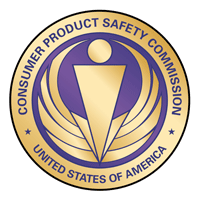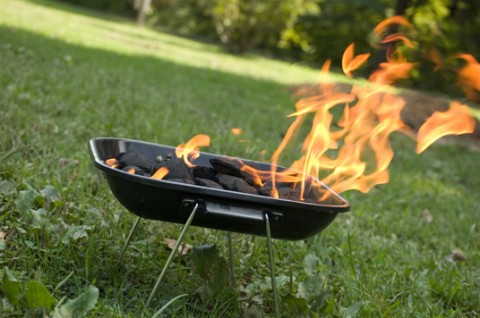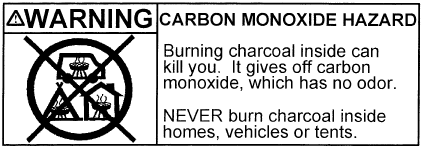 Washington, D.C. – As consumers get ready to fire up their grills this Memorial Day weekend, the U.S. Consumer Product Safety Commission (CPSC) is releasing safety tips for consumers to follow when using gas or charcoal grills.
Washington, D.C. – As consumers get ready to fire up their grills this Memorial Day weekend, the U.S. Consumer Product Safety Commission (CPSC) is releasing safety tips for consumers to follow when using gas or charcoal grills.
Please keep these safety tips in mind for the holiday weekend and anytime using outdoor grills.

Gas Grill Safety Tips
Liquid petroleum (LP) gas or propane, used in gas grills, is highly flammable. Each year about 30 people are injured as a result of gas grill fires and explosions. Many of these fires and explosions occur when consumers first use a grill that has been left idle for a period of time or just after refilling and reattaching the grill’s gas container.
To reduce the risk of fire or explosion, consumers should routinely perform the following safety checks:
- Check the tubes that lead into the burner for any blockage from insects, spiders, or food grease. Use a pipe cleaner or wire to clear blockage and push it through to the main part of the burner.
- Check grill hoses for cracking, brittleness, holes, and leaks. Make sure there are no sharp bends in the hose or tubing.
- Move gas hoses as far away as possible from hot surfaces and dripping hot grease. If you can’t move the hoses, install a heat shield to protect them.
- Replace scratched or nicked connectors, which can eventually leak gas.
- Check for gas leaks, following the manufacturer’s instructions, if you smell gas or when you reconnect the grill to the LP gas container. If you detect a leak, immediately turn off the gas and don’t attempt to light the grill until the leak is fixed.
- Keep lighted cigarettes, matches, or open flames away from a leaking grill.
- Never use a grill indoors. Use the grill at least 10 feet away from your house or any building. Do not use the grill in a garage, breezeway, carport, porch, or under a surface that can catch fire.
- Do not attempt to repair the tank valve or the appliance yourself. See an LP gas dealer or a qualified appliance repair person.
- Always follow the manufacturer’s instructions that accompany the grill.
Consumers should use caution when storing LP gas containers. Always keep containers upright. Never store a spare gas container under or near the grill or indoors. Never store or use flammable liquids, like gasoline, near the grill.
Consumers should use extreme caution and always follow manufacturer’s instructions when connecting or disconnecting LP gas containers.
Grills manufactured after October 1st, 1995, are required to have three additional safety features to eliminate leak hazards: a device to limit the flow of gas in the event of hose rupture; a mechanism to shut-off the grill; and a feature to prevent the flow of gas if the connection between the tank and the grill is not leak proof. Consumers should consider purchasing grills that have these safety features.
Charcoal Grill Safety Tips
Charcoal produces carbon monoxide (CO) when it is burned. CO is a colorless, odorless gas that can accumulate to toxic levels in closed environments. Each year about 30 people die and 100 are injured as a result of CO fumes from charcoal grills and hibachis used inside.
To reduce these CO poisonings, CPSC is offering the following safety tips:
- Never burn charcoal inside of homes, vehicles, tents, or campers. Charcoal should never be used indoors, even if ventilation is provided.
- Since charcoal produces CO fumes until the charcoal is completely extinguished, do not store the grill indoors with freshly used coals.
In April 1996, CPSC voted to revise the label on charcoal packaging to more explicitly warn consumers of the deadly CO gas that is released when charcoal is burned in a closed environment.
The new label reads, “WARNING…CARBON MONOXIDE HAZARD…Burning charcoal inside can kill you. It gives off carbon monoxide, which has no odor. NEVER burn charcoal inside homes, vehicles or tents.” The new label also conveys the written warning visually with drawings of grills inside a home, tent, and vehicle.
The drawings are enclosed in a circle with an “X” through it. While the new label requirement will not become mandatory until the end of the year, many charcoal manufacturers have already started using the new labels on charcoal packaging.
About the U.S. Consumer Product Safety Commission (CPSC)
CPSC is charged with protecting the public from unreasonable risks of injury or death associated with the use of the thousands of consumer products under the agency’s jurisdiction. Deaths, injuries, and property damage from consumer product incidents cost the nation more than $900 billion annually. CPSC is committed to protecting consumers and families from products that pose a fire, electrical, chemical, or mechanical hazard. CPSC’s work to ensure the safety of consumer products – such as toys, cribs, power tools, cigarette lighters, and household chemicals – contributed to a decline in the rate of deaths and injuries associated with consumer products over the past 30 years.
Under federal law, it is illegal to attempt to sell or resell any recalled product.
To report a dangerous product or a product-related injury, go online to: SaferProducts.gov, call CPSC’s Hotline at 800.638.2772 or teletypewriter at 301.595.7054 for the hearing and speech impaired. Consumers can obtain this news release and product safety information at www.cpsc.gov. To join a free e-mail subscription list, please go to www.cpsc.gov/cpsclist.aspx.



